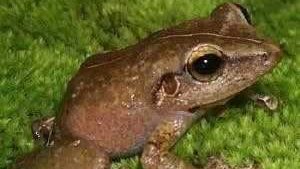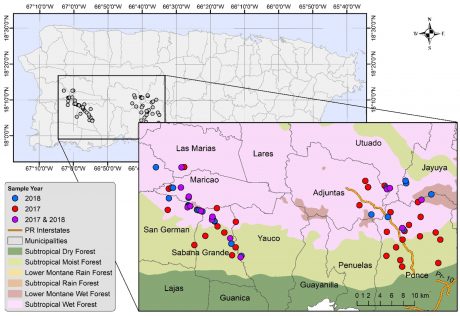New SE CASC Publication Ties Environmental Factors to Amphibian Populations in Puerto Rico

SE CASC-supported research team of Ana Rivera-Burgos, Jaime Collazo (SE CASC Faculty Affiliate), Adam Terando (SE CASC Research Ecologist), and Krishna Pacifici (SE CASC Principal Investigator) published Linking demographic rates to local environmental conditions: Empirical data to support climate adaptation strategies for Eleutherodactylus frogs, available online in the August 2021 edition of the journal Global Ecology and Conservation.
Amphibian populations are at risk globally from factors such as habitat destruction, land use patterns, pathogens (e.g., chytrid fungus), parasites, predation by introduced species, and global warming. Of the 25 species of amphibians found in Puerto Rico, 17 are species of Eleutherodactylus frogs, commonly known as coqui, which are valued culturally and also play a prominent role in the energy flow of the island’s tropical ecosystems. Nearly all of the species, of which all but two are endemic to Puerto Rico, are considered rare and three are listed as endangered and threatened. Coqui are especially vulnerable because of their limited movement and sensitivity to extremes in temperature and humidity, factors that are projected to change dramatically in coming decades. In order to protect these species, individuals may seek or be moved to refugia with environmental conditions suitable to support their continued population growth.

Researchers studied four Eleutherodactylus frog species – Melodius coqui (E. wightmanae), Grass coqui (E. brittoni), Red-eyed coqui (E. antillensis), and Common coqui (E. coqui) – with varying preferred habitats and distribution patterns across forest elevational gradients, adjusting sampling sites after Hurricane Maria (see Coping with Extreme Weather Events in Puerto Rico: Amphibian Research and Hurricane Maria). They measured two population state variables, occupancy probability and an index of abundance via acoustic sampling, and modeled their relationship to nine local abiotic (physical) and biotic (habitat) factors at the sites. They also estimated reproductive activity of E. coqui and gauged change in nesting after the hurricane.
Occupancy and abundance of E. wightmanae, E. brittoni, and E. coqui were positively and strongly influenced by mesic conditions – high humidity and lower temperatures; similarly, the probability of reproductive activity of E. coqui was highest at these sites. E. antillensis exhibited the opposite pattern, which attested to its adaptive capacity (e.g., rapid rehydration rates) to occupy habitats characterized by warmer and drier conditions. They found that changes in post-hurricane populations of coqui varied by species but were not significantly reduced, attributed to microhabitat conditions provided by downed debris.
The work is an important step in characterizing the range of environmental conditions that influence local demographics of Eleutherodactylus species, information that can indicate habitats that may act as climate refugia for these species as conditions of forests in Puerto Rico become warmer and drier (see SE CASC Researchers Simulate Climate Changes in Puerto Rico & U.S. Virgin Islands). Understanding these linkages informs conservation strategies such as managed translocations by indicating when habitat transitions from suitable to unsuitable and interventions are necessary to prevent local extinctions.
Journal Abstract
Conducting managed species translocations and establishing climate change refugia are adaptation strategies to cope with projected consequences of global warming, but successful implementation requires on-the-ground validation of demographic responses to transient climate conditions. Here we estimated the effect of nine abiotic and biotic factors on local occupancy and an index of abundance (few or chorus) for four amphibian species (Eleutherodactylus wightmanae, E. brittoni, E. antillensis, and E. coqui) in Puerto Rico, USA. We also assessed how the same factors influenced reproductive activity of E. coqui and how species responded to hurricane María (20 September 2017). As predicted, occupancy and abundance of E. wightmanae, E. brittoni and E. coqui were positively and strongly influenced by abiotic covariates (e.g., relative humidity) that characterize high elevation, mesic habitats. E. antillensis exhibited the opposite pattern, with highest probabilities (≥0.6) recorded at ≤300 m and with average relative humidity<75%. Biotic covariates (e.g., canopy cover) had a weak influence on both parameters, regardless of species. High probabilities (≥0.9) of detecting an E. coqui chorus and active nests occurred at sites experiencing average relative humidity of>80% and temperature of ≤26 °C. Moderate to high probabilities of detecting a chorus (0.4–0.7) were recorded at sites with average temperatures>26 °C, but no reproductive activity was detected, implying that monitoring abundance alone could misrepresent the capacity of a local population to sustain itself. The possibility underscores the importance of understanding the interplay between local demographic and environmental parameters in the advent of global warming to help guide monitoring and management decisions, especially for high elevation specialists. Hurricanes can inflict marked reductions in population numbers, but impacts vary by location and species. We found that the abundance (chorus) of E. antillensis and E. brittoni increased after the hurricane, but the abundance of the other two species did not differ between years. Lack of impacts was probably mediated by low structural damage to forest tracts (e.g., 9% canopy loss). Our findings help assess habitat suitability in terms of parameters that foster local population growth, which provides a basis for testing spatio-temporal predictions about demographic rates in potential climate refugia and for designing criteria to help guide managed translocations.
Authors
Ana C. Rivera-Burgos (North Carolina Cooperative Fish and Wildlife Research Unit, Department of Applied Ecology, North Carolina State University), Jaime A. Collazo (US Geological Survey, North Carolina Cooperative Fish and Wildlife Research Unit, Department of Applied Ecology, North Carolina State University), Adam J. Terando (US Geological Survey, Southeast Climate Adaptation Science Center; Department of Applied Ecology, North Carolina State University), Krishna Pacifici (Department of Forestry and Environmental Resources, Fisheries, Wildlife, and Conservation Biology Program, North Carolina State University)
Global Ecology and Conservation, Volume 28, August 2021, e01624. doi.org/10.1016/j.gecco.2021.e01624
- Categories: